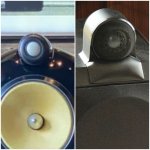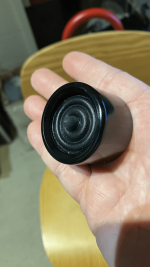I was given a link to a DIYer's B&W 802 D2 upgrade page. One of the very interesting pieces of data there was a measurement of the raw B&W D2's tweeter in the cabinet, and I wanted to share it with you all in the hopes of reading expert opinions on it. Petr focuses onthe change in directivity above 3.5 kHz, while I focus on the 5 dB disparity in output.
This is not at all a well behaved tweeter to my eyes and would make any passive crossover a real challenge. Is the change we see due to some sort of built-in wave guide effect, or uneven reflections coming from the nautilus chamber behind the tweeter, or both?

This is not at all a well behaved tweeter to my eyes and would make any passive crossover a real challenge. Is the change we see due to some sort of built-in wave guide effect, or uneven reflections coming from the nautilus chamber behind the tweeter, or both?
My initial guess would be that it's basically the baffle step. It's just much higher than you usually see, because the baffle around the tweeter is so small. While keeping the baffle small and circular helps in some ways, it is likely to generate a very distinct baffle step.
@ianbo Good call! But interestingly the previous generation doesn't seem to have suffered this, if I interpret the data from Troel's site correctly.

I see what you mean. Maybe a resonant peak at 1.7kHz in that older one? It's a much older version on Troels' site, too. And the "step" in the newer one is very sudden - might not be just the baffle. Hard to know.
I also think the dispersion in the D2 model is normal ish, I mean, it does seem to spread out a little above 3 kHz but so do many other tweets. It's the step in output that's the big deal IMHO in terms of challenging a crossover design.
The "baffle" of the older version was bigger:But interestingly the previous generation doesn't seem to have suffered this

I suppose the new tweeter has a more sudden transition to directed radiation because of this.
Maybe @PKAudio himself can chime in?
I'm also a little bit curious if this can be hacked via a change in the stuffing behind the tweeter. It's a shame I've never actually owned a B&W because I'm very curious about this particular aspect of the design. 😆
Regarding 802 D2 tweeter measurement, the step change ~4000Hz is likely something like bafflestep combined with wide, almost omi, radiation. It would be interesting to se the measurements to -180deg, unfortunately I did not do it back then.
5-10k is likely the nominal sensitivity of the tweeter. It looks like WG behavior, but I think it is not WG boost. It is just that area above 10k falls down similarly to Be domes.
The "baffle" area around the tweeter is minimal and rounded so I am not sure if any change to internals of the tweeter would help to mitigate this.
What we see here is quite an extreme, midrange beams a lot, more than typical 6" drivers, and tweeter has basically point source directivity. This is much worse than typical 6"+1", when total DI and off axis bloom can be well mitigated with less steep crossover. If I recall well, tweeter did not like crossover close to 2kHz, and I needed to keep parts count and the values/dimensions low in order to get them physically to the plinth. So at the end, with the given circumstances, the resulting off axis responses did not look as bad as I expected, and it sounded well, better then original crossover.
As the tweeter created a scoop at 10k, which is typical to almost all BW tweeters, I did not use Lpad or resistor to pad the tweeter. Low Q RLC at 10k and ~-2dB proved to provide flat trebles and sounded well. I use this approach for scan speak 9800 tweeter.
5-10k is likely the nominal sensitivity of the tweeter. It looks like WG behavior, but I think it is not WG boost. It is just that area above 10k falls down similarly to Be domes.
The "baffle" area around the tweeter is minimal and rounded so I am not sure if any change to internals of the tweeter would help to mitigate this.
What we see here is quite an extreme, midrange beams a lot, more than typical 6" drivers, and tweeter has basically point source directivity. This is much worse than typical 6"+1", when total DI and off axis bloom can be well mitigated with less steep crossover. If I recall well, tweeter did not like crossover close to 2kHz, and I needed to keep parts count and the values/dimensions low in order to get them physically to the plinth. So at the end, with the given circumstances, the resulting off axis responses did not look as bad as I expected, and it sounded well, better then original crossover.
As the tweeter created a scoop at 10k, which is typical to almost all BW tweeters, I did not use Lpad or resistor to pad the tweeter. Low Q RLC at 10k and ~-2dB proved to provide flat trebles and sounded well. I use this approach for scan speak 9800 tweeter.
Here's my analysis of this tweeter:
Summary:


Reference:
https://www.htguide.com/forum/forum...wg-horns-baffled-or-naked?p=950858#post950858
Here's another tweeter shows a similar directivity:
Summary:


Reference:
https://www.htguide.com/forum/forum...wg-horns-baffled-or-naked?p=951664#post951664

I postulate that the 802D2 tweeter's directivity is a consequence of the minimal baffle arrangement.
Summary:
Reference:
https://www.htguide.com/forum/forum...wg-horns-baffled-or-naked?p=950858#post950858
Here's another tweeter shows a similar directivity:
Summary:
Reference:
https://www.htguide.com/forum/forum...wg-horns-baffled-or-naked?p=951664#post951664

I postulate that the 802D2 tweeter's directivity is a consequence of the minimal baffle arrangement.
I wonder if the chosen measurement axis contributes to the response irregularity at 3.5kHz?
I note that PKAudio's measurement distance was 1m, and height was 4cm below the tweeter height. That's 2.3 degrees below the tweeter axis.
Stereophile measured the 802D (the previous generation} - here's the vertical response family, normalised to the tweeter axis:

There are significant dips and peaks in the region of 3.5kHz, particularly for the postions below the tweeter axis, and these are evident already at just 5 degrees. I'm guessing these are caused by the tweeter's output reflecting off top of the midrange pod, which seems to protrude a little in front of the tweeter. It's not impossible that there would be a few dB of peak and/or dip at just 2.3 degrees below.
I note that PKAudio's measurement distance was 1m, and height was 4cm below the tweeter height. That's 2.3 degrees below the tweeter axis.
Stereophile measured the 802D (the previous generation} - here's the vertical response family, normalised to the tweeter axis:
There are significant dips and peaks in the region of 3.5kHz, particularly for the postions below the tweeter axis, and these are evident already at just 5 degrees. I'm guessing these are caused by the tweeter's output reflecting off top of the midrange pod, which seems to protrude a little in front of the tweeter. It's not impossible that there would be a few dB of peak and/or dip at just 2.3 degrees below.
Last edited:
Sorry, I got muddled about what's above and below axis in that graph. Back is above axis, front is below axis. Which actually makes the point better, I think. There's a big suckout at all angles above the tweeter axis. But 5 degrees below the horizontal axis, there's a sudden bump at 3.5 to 4 kHz, maybe about 4-6dB? (There's also a peak at 4 kHz on the tweeter axis, in JA's measurements.) It's possible that even at just 2.3 degrees below the tweeter axis, there could be a bump at 3.5 kHz, relative to the on-axis.
- Home
- Loudspeakers
- Multi-Way
- The Raw B&W Nautilus Tweeter